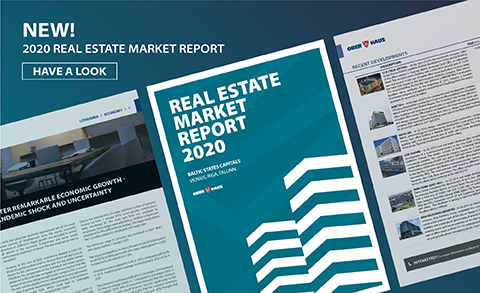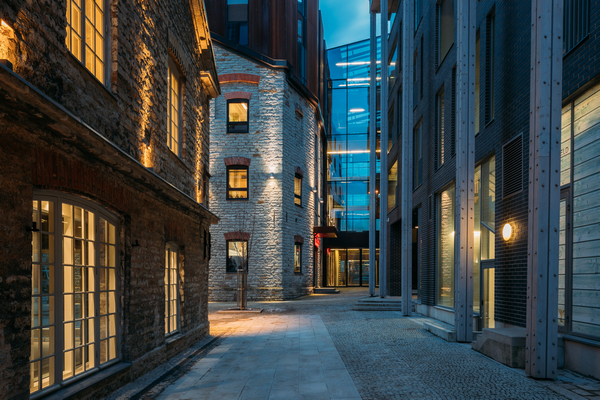Rapidly growing real estate markets in the Baltic countries to face challenges ahead
 After yet another productive year in the real estate market of the Baltic countries, at the beginning of 2020 the world became engulfed in the coronavirus disease (COVID-19). We therefore started this year with dual emotions: we still lived in an environment of growth yesterday, but today we face a great deal of uncertainty about our future. Looking at the various challenges facing the world today, the real estate market in the Baltic countries cannot remain immune from both negative and positive developments globally, reported in the latest real estate market overview of the capital cities of the Baltics by Ober-Haus, which presents a detailed analysis of the real estate market in 2019 and forecasts for the coming year.
After yet another productive year in the real estate market of the Baltic countries, at the beginning of 2020 the world became engulfed in the coronavirus disease (COVID-19). We therefore started this year with dual emotions: we still lived in an environment of growth yesterday, but today we face a great deal of uncertainty about our future. Looking at the various challenges facing the world today, the real estate market in the Baltic countries cannot remain immune from both negative and positive developments globally, reported in the latest real estate market overview of the capital cities of the Baltics by Ober-Haus, which presents a detailed analysis of the real estate market in 2019 and forecasts for the coming year.
“The rapid economic growth and growth in the real estate market in the past years have often compensated the decisions of market players, which were not always balanced and allowed them to proceed further with active business development. It is clear that in 2020 we will see a number of changes in the real estate markets, where each decision will be much more important than before. Still, various possible changes in the real estate market in the Baltic countries will certainly offer wider opportunities for both local and foreign capital investors,” Raimondas Reginis, Research Manager for the Baltics at Ober-Haus, said.
Speaking about 2019, the further impetus for the development of the real estate market in the Baltics was the significant economic growth of all three countries. The rapid increase in personal income, consumption and business development contributed to the development of both the commercial and residential real estate sectors. The situation in the real estate market in 2019 is well illustrated by at least two all-time records in Lithuania: according to Ober-Haus, investment volumes in core commercial property increased by almost 15% totalling €463 million, meanwhile investments in the residential sector reached a record €2.3 billion.
“Since the pandemic has hit the countries at the peak of activity in the past decade and the results of 2020 will be compared with very high figures of the previous year, it may be difficult for Baltic real estate market players to adapt psychologically to a reversal of the situation. If the real estate market in Latvia did not see a strong growth in the last decade, so the real estate market indicators in Estonia and Lithuania had a sizable increase,” Reginis said.
Baltic capitals start 2020 with a large supply of new housing
 The capitals of the Baltic countries continue high development activities in the residential and commercial sectors. The development in the multi-apartment segment in Vilnius and Tallinn was exceptional with the highest construction volumes since 2007–2008. Meanwhile, the level of confidence of developers in the prospects of the residential sector in Riga remained much lower. This is also reflected in the figures on construction volumes in 2019 and in the 2020 projections. According to Ober-Haus estimates, in 2019–2020 developers will build about 17 apartments per 1,000 inhabitants in the city of Vilnius, while the figure in Tallinn is 14 apartments and in Riga the figure is half that, at 7 new apartments per 1,000 inhabitants.
The capitals of the Baltic countries continue high development activities in the residential and commercial sectors. The development in the multi-apartment segment in Vilnius and Tallinn was exceptional with the highest construction volumes since 2007–2008. Meanwhile, the level of confidence of developers in the prospects of the residential sector in Riga remained much lower. This is also reflected in the figures on construction volumes in 2019 and in the 2020 projections. According to Ober-Haus estimates, in 2019–2020 developers will build about 17 apartments per 1,000 inhabitants in the city of Vilnius, while the figure in Tallinn is 14 apartments and in Riga the figure is half that, at 7 new apartments per 1,000 inhabitants.
According to Reginis, one of the important reasons limiting the confidence of developers in the housing market in Riga is the continuous decline in the number of permanent residents in this largest city of the Baltic countries. If the population in Tallinn and Vilnius has risen in the past five years by 6% and 3% respectively, so the population in Riga has fallen by almost 2%. “It is clear that, among other indicators, the changing number of potential home buyers is essential for developers in assessing further development prospects of the sector in specific regions or cities,” the Ober-Haus expert said.
Most importantly, the capital cities of the Baltic countries started 2020 with a record supply of apartments over the past decade. The capital of Lithuania leads in this area with developers planning to build around 5,200 apartments in multi-apartment buildings in a year. According to Ober-Haus, approximately 3,000 apartments are scheduled for completion in Tallinn and just over 2,500 apartments in Riga in 2020. “Given the current situation caused by the pandemic and the uncertainty in the market, it is highly likely that some developers will adjust or will be forced to postpone their development plans to a later period. It will not be surprising, therefore, if the actual construction volumes this year will be more modest than planned,” Reginis pointed out.
The rate of increase in sales prices in the Baltic capital cities in 2019 was varied. In Riga the prices went up by only 2.3%, in Vilnius – by 6.9% and in Tallinn – by 9.7%. The high level of activity of the housing market in Vilnius and Tallinn at the beginning of 2020 led market players to expect another successful year and an increase of at least 4-6% in the sales prices of apartments.
“However, the consequences of the coronavirus pandemic may have a negative impact on housing prices in the second half of this year and the overall annual price change in the Baltic capitals may be negative. Depending on the duration of the pandemic and its impact on global and national economies, the fall in prices may be either limited to a symbolic decline of a few percent or we may see a double-digit fall in prices,” the representative of Ober-Haus said.
The recovering office space sector in Riga may slow down
Following active development in 2018–2019, the office segment was ready for a further significant leap in supply in all Baltic capitals. According to Ober-Haus, in 2018–2019, a total of 290,000 sqm office space was built in Tallinn, Riga and Vilnius, so it is realistic to expect that over 300,000 sqm of office space could be completed in 2020–2021.
The results in Riga are particularly promising as the lack of office supply previously prevented Riga from fully competing with Tallinn or Vilnius for the attention of international companies. According to Ober-Haus, in 2019 the market in Riga was supplemented with nearly 56,000 sqm of new office space (66,000 sqm in Vilnius and 20,000 sqm in Tallinn). In 2020–2021, more than 70,000 sqm of office space should be completed in the capital of Latvia, which would provide a solid basis for the city in its claim for potential tenants of foreign capital. It will therefore be very interesting to see how both domestic and foreign capital companies respond to the abundant new office space supply in Riga.

Raimondas Reginis, Research Manager for the Baltics at Ober-Haus
However, at the beginning of 2020, Riga faced two challenges: a significant sudden surge in supply and a coronavirus pandemic threatening the whole economy of the country. In 2019, the increase in the modern office space in Riga increased the office vacancy rate from 4.5% to 8.5% in a year. “A similar situation was recorded in Kaunas (Lithuania) in 2019, where a significant increase in the new office space increased the vacancy rate to double digits. In these cities it takes more time for the market to fully absorb the large supply than it does, for instance, in Vilnius or Tallinn,” Reginis pointed out.
Meanwhile, the vacancy rate in Tallinn and Vilnius did not change significantly in 2019 and at the end of the year stood at 3% in Vilnius and 4% in Tallinn. Encouraged by high absorption rates at business centres in Vilnius, developers are very enthusiastic in this city and plan to offer at least 170,000 sqm of office space to the market in 2020–2021 (in projects that are currently being completed and in progress).
According to the Ober-Haus expert, these development plans would be justified in a growing economic environment and would not be surprising, but the situation at the beginning of 2020 looks less optimistic. “Under the conditions of an increasingly fast-growing supply, further slowing down or even shrinking business development could significantly increase the modern office space vacancy rates in Vilnius, particularly since the current vacancy rate is the lowest in the past 12 years” Reginis said. Even if all business centres that opened in Vilnius in 2019 were fully leased, it would be much more difficult to expect the same situation in 2020 or 2021. Although some of the recently launched projects may yet be suspended or their construction may be postponed to a later period (not only because of the uncertainty in the real estate market, but also because of external financing), most of the projects currently under construction are already well under way and it seems that the developers will endeavour to complete them.
However, the overall vacancy rate may increase not only due to the new supply of office space, but also due to the migration of tenants, who will move to newly opened buildings leaving a significant amount of vacant premises in older buildings. “Therefore, if the forecasts of the country’s economic decline are confirmed and if we see the overall increase in vacancy rates of office space in the market in the near future, the situation may be very different for specific projects. While some property owners enjoy full occupancy with recession-resilient tenants, others may have to face, at least temporarily, high vacancy rates and a significant reduction in income,” Reginis said.
Full review (PDF): Baltics Real Estate Market Report 2020
Latest news
 All news
All news

“e-market city” completes its second phase – the development of a modern “stock office” type shopping town continues
"e-market city", an online and wholesale shopping town located in a business-friendly location at the intersection of Eišiškių pl. and Geologų Street, is rapidly approaching the end of its second phase. The final construction works are currently underway and the first tenants of the new phase are preparing to move in as early as June-July. "The predominant floor areas of e-market city - ranging from 370 to 960 m² - are easily combinable and adaptable to a wide range of commercial activities. Existing and potential tenants appreciate the easy accessibility, high quality of construction and fitting-out, functional layout and solid neighbourhood, where well-known companies such as Assa Abloy, Dextera, Skuba, Skuba, Maidina, Šildymas plius, YE International, etc. are already located. The first phase is already 100% leased, while the second phase is still available - we invite you to get in touch", says Remigijus Valickas, Commercial Real Estate Projects Manager at Ober-Haus. The project is being developed in three phases on an area of 3.9 ha. The total area of the buildings will exceed 20,000 m² and the total investment in the project will amount to more than EUR 25 million. For more information about the project and leasing opportunities,…

The recovery of a very strong-looking housing market may slow down
The Ober-Haus Lithuanian apartment price index (OHBI), which follows changes in apartment sale prices in the five biggest Lithuanian cities (Vilnius, Kaunas, Klaipėda, Šiauliai and Panevėžys) increased by 0.5% in March 2025. The annual apartment price growth in the biggest cities of Lithuania was 4.3% (a 4.1% increase was recorded in February 2025). In March 2025 apartment prices in Vilnius, Kaunas, Šiauliai and Panevėžys increased by 0.4%, 1.3%, 0.4% and 0.2%, respectively, with the average price per square meter reaching EUR 2,680 (+10 EUR/sqm), EUR 1,846 (+24 EUR/sqm), EUR 1,172 (+4 EUR/sqm) and EUR 1,149 (+2 EUR/sqm). In the same month, apartment prices in Klaipėda decreased by 0.1% and the average price per square meter dropped to EUR 1,752 (-2 Eur/sqm). In the past 12 months, the prices of apartments increased in all the biggest cities in the country: 3.3% in Vilnius, 5.6% in Kaunas, 5.4% in Klaipėda, 6.5% in Šiauliai and 6.4% in Panevėžys. "At the beginning of 2025, the country's housing market is showing impressive results. After a very strong growth in housing transactions in January and February this year, the increase in the number of transactions continued in March. According to the data of the State Enterprise…

Housing market has woken up, but no faster price growth yet
The Ober-Haus Lithuanian apartment price index (OHBI), which follows changes in apartment sale prices in the five biggest Lithuanian cities (Vilnius, Kaunas, Klaipėda, Šiauliai and Panevėžys) increased by 0.4% in February 2025. The annual apartment price growth in the biggest cities of Lithuania was 4.1% (a 4.0% increase was recorded in January 2025). In February 2025 apartment prices in Vilnius, Kaunas, Klaipėda, Šiauliai and Panevėžys increased by 0.3%, 0.1%, 0.8%, 0.8% and 0.9%, respectively, with the average price per square meter reaching EUR 2,670 (+7 EUR/sqm), EUR 1,822 (+2 EUR/sqm), EUR 1,754 (+13 EUR/sqm), EUR 1,168 (+10 EUR/sqm) and EUR 1,147 (+10 EUR/sqm). In the past 12 months, the prices of apartments increased in all the biggest cities in the country: 3.2% in Vilnius, 4.1% in Kaunas, 6.2% in Klaipėda, 6.6% in Šiauliai and 6.7% in Panevėžys. ‘As predicted, a rapid annual growth in the number of housing transactions is recorded at the beginning of 2025. According to the data of the State Enterprise Centre of Registers, 40% more apartments were purchased in the country in January this year and 39% more in February this year than in the same month in 2024. It should be noted that in the…
 All news
All news


